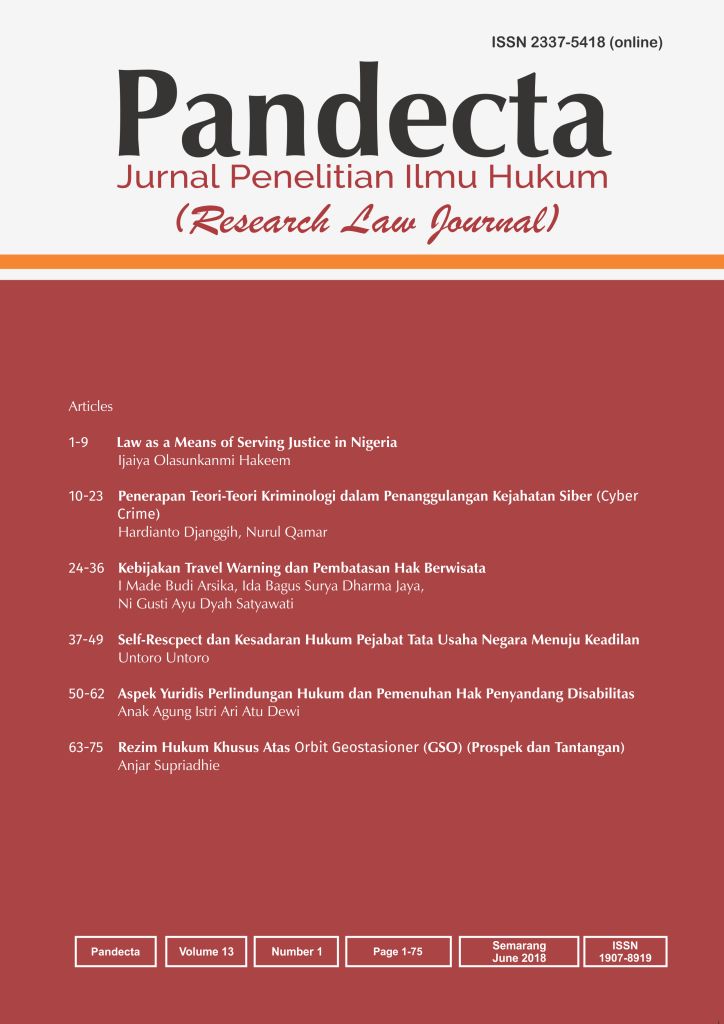Are BUMN/State-Owned Enterprises (SOES) Hybrid Organizations?
(1) Faculty of Law Universitas Indonesia
Abstract
Keywords
Full Text:
PDFReferences
Achmad, S. (1963). The Dynamics of The Nationalization of Dutch-Owned Enterprises in Indonesia: a Political, Legal, Economic Development and Administrative Anaysis. Indiana: Indiana University.
Asshiddiqie, J. (1994). Gagasan Kedaulatan Rakyat Dalam Konstitusi dan Pelaksanaannya di Indonesia. Jakarta: Ichtiar Baru.
Atika, D. B. (2013, Juli-Desember). Pelayanan Publik Berkarakter Prima: Sebuah Pendekatan Teoritik. Jurnal Ilmiah Administrasi Publik dan Pembangunan, 4(2).
Bart Voorn, M. L. (2017). The efficiency and effectiveness of municipial owned corporations: a systematic review. Local Government Studies, 43(5), 820-841. doi:10.1080/03003930.2017.1319360
Billis, D. (2010). Hybrid Organization and the Third Sector: Challenges for Practice, Theory and Policy. In D. Billis (Ed.), Hybrid Organization and the Third Sector: Challenges for Practice, Theory and Policy (pp. 46-69). Basingstoke, UK: Palgrave.
C. Skelcher, N. M. (2005). The Public Governance of Collaborative Spaces: Discourse, Design and Democracy. Public Administration, 83 (3), 573-596.
Christensen, L. (2017). How Hybridity has Evolved in the Governance of State-Owned Enterprises: Evidence from Danish and Swedish Passanger Rail Services from 1990 to 2015. Public Money and Management, 37 (6), 401-408. doi:https://doi.org/10.1080/09540962.2017.1344016
Cooney, K. (2006). The Institutional and Technical Structuring of NonProfit Ventures: Case Study of a U.S. Hybrid Organization Caught Between Two Fields. Voluntas, 17(1), 143-161.
Didu, M. S. (2018). BUMN sebagai Benteng Pertahanan Ekonomi Nasional dan Buffer Perekonomian Rakyat. Bincang Seru. Jakarta.
Evers, A. (2005). Mixed Welfare Systems and Hybrid Organizations: Changes in the Governance and Provision of Social Services. International Journal of Public Administration, 28 (1), 737-748.
Fitriani, I. (2011). Pola Pengelolaan Badan Usaha Milik Negara Sebuah Potret Singkat. Manajerial, 10(2),19, 54-75.
Gidron, Y. H. (2005). Undrstanding Multi-Purpose Hybrid Voluntary Organizations: The Contributions of Theories on Civil Society, Social Movements and Non-Profit Organizations. Journal of Civil Society, 1(2), 97-112.
Hamid, E. S. (1999). Peran dan Intervensi Pemerintah dalam Perekonomian. Jurnal Ekonomi Pembangunan, 4(1),41-58.
Harris, F. (2007). Kedudukan Negara sebagai Penyertaan Modal dalam PT Persero: Pengubahan Ketentuan yang Tidak Sesuai Dengan Prinsip-prinsip Hukum Perusahaan. Jakarta: Disertasi Program Pascasarjana Fakultas Hukum Universitas Indonesia.
Hartono, D. (2014). Tinjauan Keuangan Negara dari Perpsektif Hukum Perseroan dan Economic Analysis of Law. In Y. Indrawati (Ed.), Aktualisasi Hukum Keuangan Publik (pp. 227-250). Bandung: Mujahid Press.
Ibrahim, J. (2006). Teori dan Metodologi Penelitian Hukum Normatif. Malang: Bayumedia.
Indrawati, Y. (2014). Economic Analysis of Law (EAL) atas Ketentuan Pasal 2 huruf g Undang-Undang No. 17 Tahun 2003 tentang Keuangan Negara. In Y. Indrawati (Ed.), Aktualisasi Hukum Keuangan Publik (pp. 251-268). Bandung: Mujahid Press.
Karre, P. M. (2009). Boundary Spanning in Practice - Consequences of Working on The Border Between Public and Private. International Conference: Towards Knowledge Democracy. Leiden.
Karre, P. M. (2011). Heads and Tails: Both Sides of The Coin, An Analysis of Hybrid Organizationz in The Dutch Waste Management Sector. Den Haag: Eleven International Publishers.
Kasim, H. (2016). Memikirkan Kembali Pengawasan Badan Usaha Milik Negara Berdasarkan Business Judgement Rules. Jurnal Konstitusi, 14(2), 441.
Khairandy, R. (2009). Korupsi di Badan Usaha Milik Negara Khususnya Perusahaan Perseroan: Suatu Kajian atas Makna Kekayaan Negara yang Dipisahkan dan Keuangan Negara. Jurnal Hukum, 16(1), 73-87.
Koppel, J. G. (2003). The Politics of Quasi-Government, Hybrid Organizations and The Dynamics of Bureaucratic Control. Cambridge: Cambridge University Press. Retrieved from www.cambridge.org/9780521525602
Muntaqo, M. Z. (2018, Desember). Penerapan Prinsip Detournemen de Pouvoir Terhadap Tindakan Pejabat BUMN yang Mengakibatkan Kerugian Negara Menurut Undang-Undang Nomor 17 Tahun 2003 tentang Keuangan Negara. Nurani, 18(2), 177-194.
Nugraha, S. (2002). Privatisasi di Berbagai Negara. Jakarta: Lentera Hati.
Pangestu, M. (1996). Economic Reform, Deregulation and Privatization.
Powell, W. (1987). Hybrid Organizational Arrangements: New Form or Transitional Development? California Management Review, 30(1), 67-87.
Putters, T. B. (2005). Griffins or Chameleons? Hybridity as a Permanent and Inevitable Characteristic of the Third Sector. International Journal of Public Administration, 28(1), 749-765.
Putusan MK, Nomor 48/PUU-XI/2013 (Mahkamah Konstitusi 2013).
Rahardjo, M. D. (1995). Bank Indonesia Dalam Kilasan Sejarah Bangsa. Jakarta: LP3ES.
Rainey, J. P. (1998). The Public-Private Distinction in Organization Theory: a Critique and Research Strategy. The Academy of Management Review, 13(2), 182-201.
Riberio, P. M. (2005). The Social Profit of Hybrid Service Delivery. EGPA Conference. Berne.
Rothschild-Whitt, J. (1979). The Collective Organization: an Alternative to Rational-Bureaucratic Models. American Sociological Review, 44(1), 509-527.
Saragih, J. P. (2014). Politik dan Ekonomi Kebijakan Privatisasi Badan Usaha Milik Negara. Jurnal Ekonomi dan Pembangunan, 22(1), 83-105.
Schmitz, P. W. (2000). Partial Privatisation and Incomplete Contrats: The Propoer Scope of Government Reconsidered. FinanzArchiv, 57(1), 394-411.
Sidak, D. E. (2003). Competition Law for State-Owned Enterprises. Antitrust Law Journal, 71(2), 479-523.
Sidik, M. (2014). Analisis Peran Badan Usaha Milik Negara dalam Pembangunan, Keuangan Negara dan Kinerjanya sebagai Korporasi. In Y. Indrawati (Ed.), Aktualisasi Hukum Keuangan Publik (pp. 269-316). Bandung: Muhajid Press.
Simatupang, D. P. (2011). Paradoks Rasionalitas Perluasan Ruang Lingkup Keuangan Negara dan Implikasinya Terhadap Kinerja Keuangan Pemerintah. Jakarta: Badan Penerbit FHUI.
Spear, C. C. (2010). The Governance of Hybrid Organisations. In D. Billis (Ed.), Hybrid Organizations and The Third Sector: Challanges for Practice, Theory and Policy (pp. 70-89). Basingstoke, UK: Palgrave.
Sumarni. (2013). Intervensi Pemerintah antara Kebutuhan dan Penolakan di Bidang Ekonomi. ECONOMICA Journal of Economic and Economic Education, 1(2), 183-194. doi:http://dx.doi.org/10.22202/economica.2013.v1.i2.118
Taco Philip Bradsen, M. K.-K. (2009). The Risks of Hybrid Organisation: Expectations and Evidence. NISPACEE Conference. Budva.
Wahyuni, E. (2010). Kebijakan dan Manajemen Privatisasi BUMN/BUMD. Yogyakarta: Yayasan Pembaruan Administrasi Publik Indonesia.
Wrihatnolo, R. N. (2008). Manajamen Privatisasi BUMN. Jakarta: Gramedia.
Refbacks
- There are currently no refbacks.


